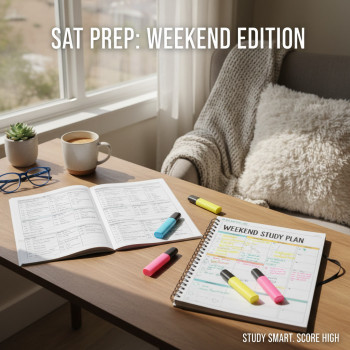When the clock starts ticking: a friendly roadmap for last-minute SAT retakes
Take a breath. You opened this article because you want to retake the Digital SAT and the deadline is closer than you’d like. That anxious knot — of college apps, extracurriculars, and end-of-term exams — is familiar to almost every student. The good news? Time-limited retakes can still deliver meaningful score gains if you plan smart, focus ruthlessly, and use the right tools. This guide gives you a practical, human-centered plan you can start using today, whether you have two weeks, a month, or a couple of months before registration closes.
Why a retake can be the smartest move — even with little time
Before we jump into tactics, it helps to understand the why. Retaking the SAT often yields better scores because:
- You know the format and timing pressures of the Digital SAT now — that reduces test-day anxiety.
- Your score report identifies specific skill gaps, so you can study with purpose rather than guessing.
- Small, targeted improvements in timing, strategy, and a few content areas can add up to a real score increase.
Put simply: under time pressure, quality of practice beats quantity. You don’t need months of study to improve — you need a focused plan.
Step 1 — Make a calm, data-driven decision (48–72 hours)
First things first: look at your most recent score report and be honest with yourself. Where did you lose the most points? Was it careless mistakes, running out of time, or specific content areas like algebra or command of evidence?
A quick diagnostic checklist
- Open your score report and note your section-level scores and question-level breakdown (Digital SAT reports usually show where you performed well and where you didn’t).
- Identify 2–3 highest-impact weaknesses (for example, “algebra word problems,” “evidence-based reading inference,” or “time management in Math Section 2”).
- Decide whether a retake is realistic given deadlines and application timelines — sometimes one retake is enough if you correct a few consistent mistakes.
This initial review should take under two hours. It’s the foundation for everything that follows.
Step 2 — Build a laser-focused study plan (1 hour to create)
With your weaknesses identified, craft a compact plan that targets improvements where they’ll make the most difference. If you’re short on time, avoid broad review sessions and instead concentrate on specific skills and test habits.
How to prioritize what to study
- High-frequency topics: Concentrate on content that appears most often (algebra, linear equations, interpreting graphs, paired passages, command of evidence).
- Slip-up patterns: If careless errors cost you, create a rule-based checklist to catch those mistakes (e.g., “underline the question stem before solving”).
- Timing hot-spots: Practice the last 10 questions on math sections or multi-paragraph reading sets — these often reveal timing breakdowns.
Sample 4-week plan (condensed for tight timelines)
| Week | Focus | Daily Time | Goal |
|---|---|---|---|
| Week 1 | Diagnostic review + core weaknesses | 1–2 hours | Understand errors; finish targeted practice sets |
| Week 2 | Timing and strategy drills | 1–2 hours | Improve pacing; reduce careless mistakes |
| Week 3 | Full-length digital practice tests + review | 2–3 hours per test day | Simulate test day and refine test plan |
| Week 4 (final week) | Light practice, strategy tune-up, rest | 30–60 minutes | Be sharp and confident on test day |
Adjust the plan to the time you actually have: condense weeks if you only have two weeks, or spread out content over two months if you have more time.
Step 3 — Practice the Digital format (the Bluebook effect)
The Digital SAT has its own feel: you’ll use the Bluebook testing app, navigate digital passages and graphs, and manage timing differently than paper tests. If you haven’t spent real practice time in the digital format, prioritize that immediately.
What to practice in Bluebook and Khan Academy
- Full-length practice tests in Bluebook to mimic the interface, timing, and on-screen tools.
- Official practice on Khan Academy tailored to your score report gaps.
- Short digital drills where you practice navigation: highlighting, flagging, and jumping between questions.
Familiarity breeds confidence. Even one or two full digital practice tests will reduce a surprising amount of test-day friction.
Step 4 — Make every practice minute count (quality over quantity)
When time is limited, micro-improvements matter. Use deliberate practice: short, intense sessions with immediate feedback.
High-impact practice techniques
- Targeted sets: 15–30 minute question sets focused on a single skill (e.g., “linear equations only”).
- Explain aloud: After solving, say your reasoning out loud — this reveals shaky thinking faster than silent review.
- Error logs: Keep a one-page mistake tracker with the question type, why you missed it, and a 10-word correction note you can review daily.
- Timed mini-drills: 12–15 minute bursts for reading passage pairs or math problem clusters to practice pacing.
Step 5 — Test simulation and smart review
One or two full-length practice tests are invaluable, but what you do after them matters even more.
How to run a useful simulation
- Simulate test day: use the Bluebook app, follow exact start times, and avoid breaks beyond those permitted.
- Keep the environment quiet, and use the same desk/setup you’ll have on test day when possible.
- After the test, spend 60–90 minutes reviewing every mistake — not just the right answer, but the thought process that led you there.
Review strategy (the 3-pass method)
- Pass 1: Categorize each missed question — content error, careless mistake, or timing issue.
- Pass 2: Re-solve the problem without looking at the solution. Write the shortest correct reasoning you can.
- Pass 3: Create a one-line principle you’ll remember (e.g., “When variables are in numerator and denominator, clear denominators first”).
Step 6 — Test-day logistics and psychological prep
Logistics are boring — and they matter. Sorting out the small details beforehand saves mental energy and prevents avoidable stress.
Checklist for the week before
- Confirm test registration and device requirements: if you borrowed a device, check any earlier deadlines to request one through College Board.
- Charge devices, update Bluebook, and practice with the exact app.
- Pack: charger, photo ID, pencils (for scratch paper), snacks, and a printed admission ticket if you prefer a backup.
- Sleep and nutrition: prioritize rest — your brain needs recovery to consolidate learning.
Mental strategies to calm nerves
- Practice a short breathing routine: inhale 4 counts, hold 4, exhale 6 — this resets anxiety quickly.
- Use an anchor phrase: “I’ve prepared; I will use my plan.” Repeat it before the test and at the start of each section.
- Micro-goals: focus on one question at a time. Don’t let the scoreboard or difficulty of a question affect the next one.
Step 7 — Make the decision timeline for retakes
Retake timing is strategic. With limited time, you should weigh registration deadlines against how much improvement you can realistically achieve.
Decision flow — simple and practical
- If you’re already scoring within striking distance of your target (e.g., 10–50 points away), a single focused month of work can be enough.
- If the gap is larger, prioritize the next available test where you can realistically complete at least one full practice cycle and a few targeted weeks of study.
- Factor in score release timelines — know when colleges see your updated scores relative to application deadlines.
Step 8 — Use support smartly: tutoring, tools, and time-saving resources
When time is tight, having someone show you the fastest path matters. Personalized tutoring, targeted practice platforms, and focused planning can accelerate gains.
What to look for in quick, effective support
- 1-on-1 guidance that begins with a diagnostic and an exact plan tailored to your weaknesses.
- Expert tutors who prioritize strategy and quick wins — pacing, common trap recognition, and high-yield content.
- AI-driven insights or analytics that highlight the most frequent error types from your practice tests.
For example, Sparkl’s personalized tutoring model can fit naturally into a compressed timeline: expert tutors create targeted study plans, provide one-on-one strategy coaching, and use data to pinpoint the exact skills to sharpen. That kind of focused support can turn limited time into efficient improvement when it’s used alongside your practice tests.
Step 9 — Real-life examples: how small changes add up
Stories help clarify abstract advice. Here are two condensed examples that show how focused adjustments produced measurable gains.
Case study A — Maya (two weeks before the retake)
Maya had a 620 Math and 640 Evidence-Based Reading and Writing. She had two weeks. Her diagnostic showed most errors were careless slips on arithmetic and misreading paired passage question stems. Her plan:
- Two 30-minute daily arithmetic drills (mental math and fraction-decimal conversions).
- One reading passage per day with a focus on underlining the question stem and writing a 3-word answer plan before looking at choices.
- Two full Bluebook practice sections on weekends.
Result: Maya eliminated many careless slips and improved pacing. Her retake returned a combined 40-point gain. Small, repeatable habits mattered more than cramming.
Case study B — Jordan (six weeks, bigger gap)
Jordan needed a larger jump. He had six weeks and focused on high-yield algebra topics, parallel practice tests, and weekly tutor sessions for strategy. He tracked errors, did targeted drills, and used one-on-one tutoring to rethink how he approached multi-step problems. The outcome: a steady improvement culminating in a 90-point increase — the kind of result earned through targeted instruction married to disciplined practice.
Step 10 — Final-week timeline: sharpen, don’t burn out
The week before the test is about consolidation. Here’s a tight schedule that keeps you sharp and rested.
7-day pre-test plan
- Day 7–5: One timed full section per day; focused review of mistakes (30–60 minutes).
- Day 4–3: One full-length Bluebook practice test; detailed review but avoid heavy new learning.
- Day 2: Light practice (30 minutes), review error log; double-check test materials and logistics.
- Day 1: Rest, short breathing practice, light review of one-page formula or strategy sheet, early to bed.
- Test day: follow your plan, use your pacing tricks, and don’t linger over any single question more than the allotted time.
Quick-reference strategies to remember during the test
- Answer easy questions first: build momentum and ensure raw points aren’t left on the table.
- When in doubt, eliminate clearly wrong answers; narrowing choices increases odds of guessing correctly.
- Flag and move on: if a question will take more than your per-question time allotment, flag it and return later.
- Use on-screen tools effectively — highlight, strikethrough, and the built-in calculator when allowed.
Measuring success beyond the score
A higher score is the goal, but the process yields other wins: better study habits, clarity around academic strengths, and increased confidence — skills that help in college and beyond. Even if the score improvement is smaller than you hoped, the strategic skills you build are lasting.
When to stop chasing a marginal point gain
If you’re making tiny improvements but burning time that could be used for college apps, internships, or rest, reassess. Sometimes sending a well-rested, reliable score beats squeezing out five more points at the cost of exhaustion.
Closing thoughts — focus, calm, and clever practice
Retaking the Digital SAT under a tight deadline is not a crisis — it’s a challenge that rewards clarity. Use your score report as a map, prioritize the highest-impact fixes, simulate the digital format, and practice with purpose. If you have access to one-on-one help, such as focused tutoring that provides tailored plans and data-driven insights, it can compress months of learning into a few effective weeks. But even solo students can make big strides by concentrating on the few things that matter most: timing, common content weaknesses, and avoiding careless mistakes.
Start today with a two-hour audit of your last score report, write down the three most common problems you see, and build a short daily plan to address them. With calm, consistent effort, you’ll be surprised how much improvement is possible — even when the deadline is close.
One last practical table — what to do depending on how much time you have
| Time Available | Top Priority | Daily Commitment | Realistic Expectation |
|---|---|---|---|
| Less than 2 weeks | Correct careless errors & practice digital interface | 45–90 minutes | 10–40 point gains |
| 2–6 weeks | Targeted content drills + pacing drills | 1–2 hours | 30–90 point gains |
| 6+ weeks | Comprehensive plan with 1–2 full tests/week | 2+ hours | 50–150+ point gains (varies by starting point) |
You don’t need to be perfect; you need to be purposeful. If a personalized touch would help—whether that’s a weekly check-in with a tutor, a tailored study plan, or AI-driven error analysis—consider short-term, targeted tutoring options to multiply your study time. With the right plan, even limited time can deliver meaningful improvement.
Ready to make a plan?
Start with your score report, prioritize the three most frequent error types, and schedule your first digital practice test in Bluebook. If you want a tailored one-on-one plan that fits the clock you’re working with, personalized tutoring and focused coaching can help you turn pressure into progress. Good luck — you’ve got this.














No Comments
Leave a comment Cancel